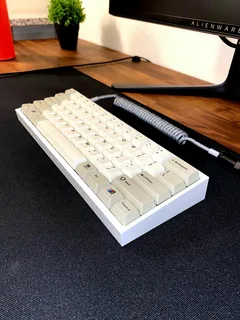Mechanical keyboards have become a favorite choice for gamers, programmers, and enthusiasts alike due to their tactile feedback, durability, and customizability. Small mechanical keyboards, especially compact 60% or 75% layouts, are gaining popularity for their portability and minimalist design. If you’re looking to take your small mechanical keyboard to the next level, customizing it can make a huge difference in both aesthetics and functionality. This guide will walk you through the essential steps to customize your small mechanical keyboard like a pro.
Why Customize Your Small Mechanical Keyboard?
Before we dive into the customization process, let’s discuss why you should consider personalizing your keyboard.
-
Personal Expression: Customizing your keyboard allows you to showcase your unique style, from keycaps to lighting effects.
-
Ergonomics: Tailoring your keyboard’s layout and switches can improve comfort, reducing strain during long typing sessions.
-
Improved Performance: A custom layout or specific switches might enhance your typing or gaming experience, giving you the edge in productivity or competitive gaming.
Now, let’s explore how to customize your small mechanical keyboard to fit your needs and preferences.
1. Choosing the Right Switches
One of the most significant factors in customizing your keyboard is selecting the right switches. Mechanical switches come in various types, each with distinct characteristics. The three most common types are:
-
Linear Switches: Smooth keystrokes with no tactile bump, ideal for gamers who need quick and consistent presses.
-
Tactile Switches: Offers a tactile bump to notify you when a keypress is registered, popular for typists who want to feel their keypresses.
-
Clicky Switches: Similar to tactile switches but with an added audible click. These are great for people who enjoy the sound of their keystrokes.
Choosing the right switches is an essential first step to customize your small mechanical keyboard like a pro. Whether you’re typing all day or gaming intensely, the right switch can significantly impact your experience.
2. Upgrading Keycaps
Keycaps are one of the easiest and most visual ways to customize your small mechanical keyboard. With endless styles, colors, and materials to choose from, you can completely transform the look of your keyboard. Here’s how to choose the perfect keycaps:
-
Material: Keycaps are typically made of ABS or PBT plastic. PBT keycaps are more durable and resistant to wear and tear, while ABS keycaps tend to shine after prolonged use.
-
Profile: Keycaps come in different profiles, such as Cherry, SA, and OEM. Each profile offers a different feel when typing, so it’s worth experimenting to find the one that suits you best.
-
Design and Color: From retro styles to RGB-compatible designs, you can find keycaps that match your personal taste and the aesthetics of your setup.
Swapping out the default keycaps is a simple yet effective way to customize your small mechanical keyboard like a pro. Whether you prefer a sleek, minimalist look or want vibrant, personalized colors, the keycaps are where your creativity can shine.
3. RGB Lighting Customization
Many mechanical keyboards come with RGB lighting, but a pro-level customization involves more than just turning on the default lighting. Here’s how to get the most out of your RGB setup:
-
Software Control: Use the keyboard’s dedicated software (such as Razer Synapse, Logitech G Hub, or Corsair iCUE) to customize your lighting profiles. Create dynamic effects that react to keystrokes or display stunning color gradients.
-
Lighting Zones: Some small mechanical keyboards allow you to control different lighting zones. You can highlight specific keys, like your WASD keys for gaming, or create a color scheme that fits your workspace vibe.
-
Advanced Effects: Take it a step further by setting up animations like waves, breathing effects, or even synchronized lighting with your PC’s audio or game.
By mastering RGB lighting customization, you’ll give your keyboard a truly professional and personalized flair.
4. Customizing the Layout
Many small mechanical keyboards offer hot-swappable switches and programmable keys. If your keyboard has these features, you can customize its layout to suit your workflow or gaming style. Here’s what you can do:
-
Reassign Keys: Using software like QMK or VIA, you can reassign keys to perform specific functions. For example, you can set your keyboard to switch between different layers for gaming or productivity purposes.
-
Create Macros: Macros are sequences of keystrokes that are triggered with a single keypress. This is especially useful for gamers who need to execute complex commands quickly or for programmers looking to streamline repetitive tasks.
-
Custom Layers: If your keyboard has multiple layers (such as the Fn layer), you can create custom layers to add even more shortcuts or functions that suit your needs.
With these powerful options, you can fully customize your small mechanical keyboard like a pro by creating a layout that improves your efficiency and performance.
5. Adding Dampening Mods
For those who want to achieve a quieter, smoother typing experience, adding dampening mods is a great way to further customize your keyboard. These mods are usually applied inside the case to reduce noise and improve acoustics.
-
Silencing Rings: Also known as O-rings, these can be placed on the keycaps to reduce the sound of bottoming out the keys.
-
Foam Mods: Adding dampening foam inside the keyboard case can absorb excess noise and vibrations, making each keystroke feel more refined.
-
Lubing Switches: If you’re feeling particularly adventurous, you can disassemble your switches and apply lubricant to the moving parts. This reduces friction and can significantly smoothen keypresses.
By incorporating these mods, you’ll be able to enjoy a quieter, more refined typing experience, making your mechanical keyboard feel even more professional.
Conclusion
Customizing your small mechanical keyboard can elevate both its aesthetic and functional performance. From choosing the right switches to adding RGB lighting and personalizing the layout, there are countless ways to make your keyboard truly your own. Whether you’re a casual typist or a competitive gamer, customizing your small mechanical keyboard like a pro can enhance your overall experience. So, dive in, experiment, and create a setup that reflects your personal style and needs!


